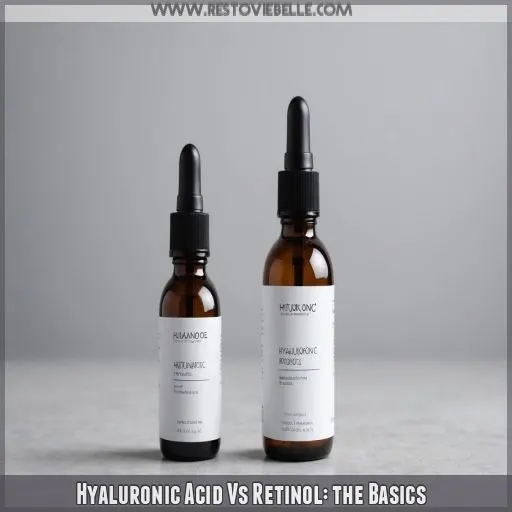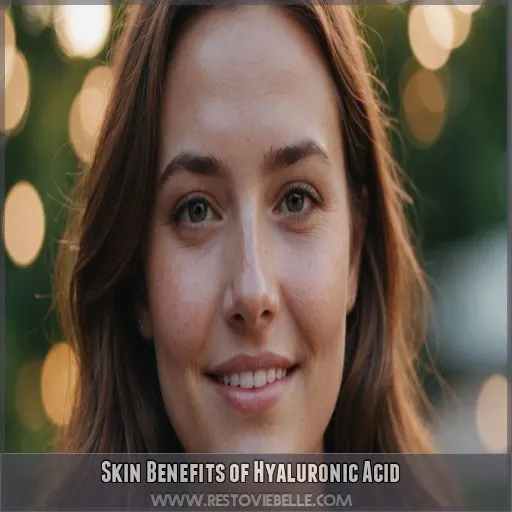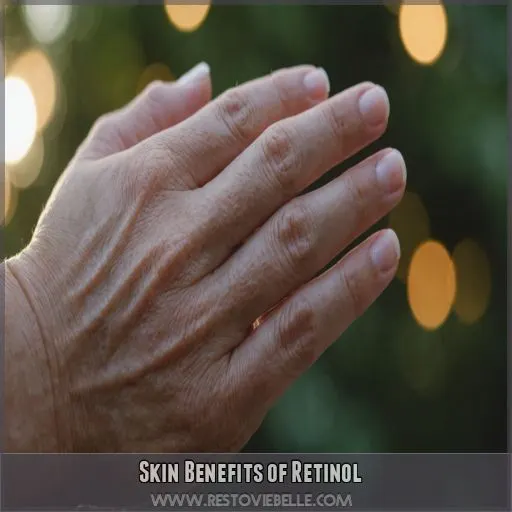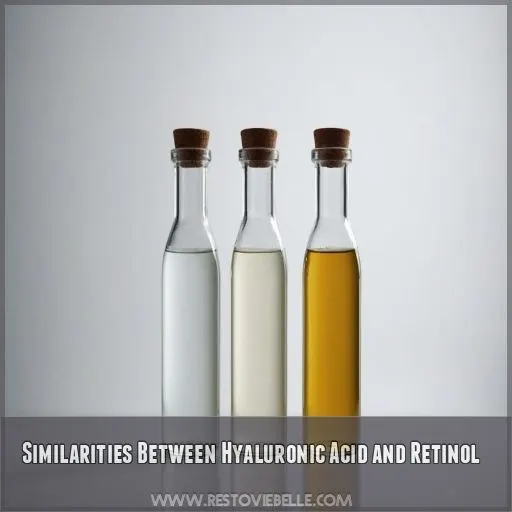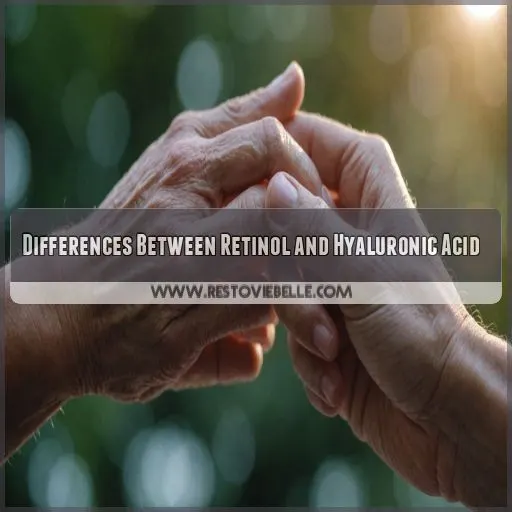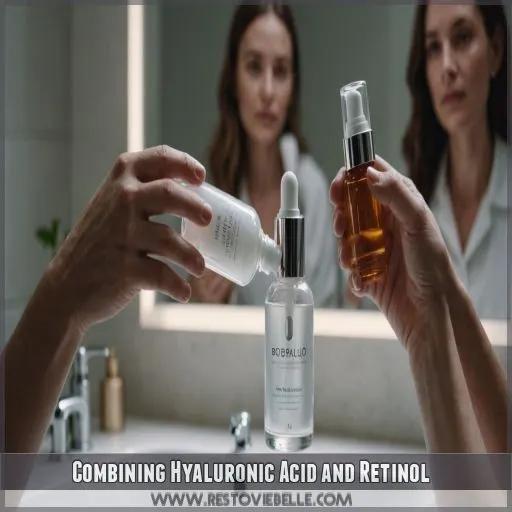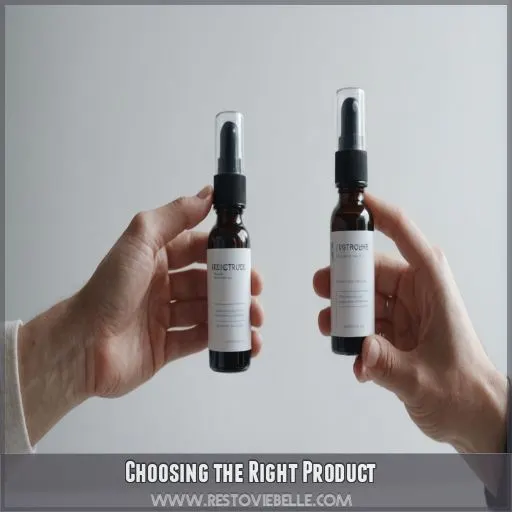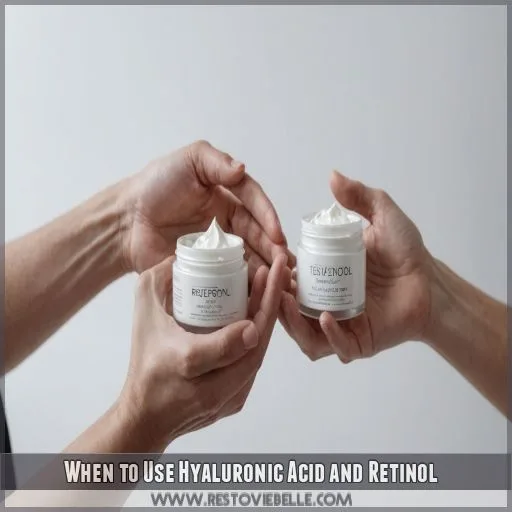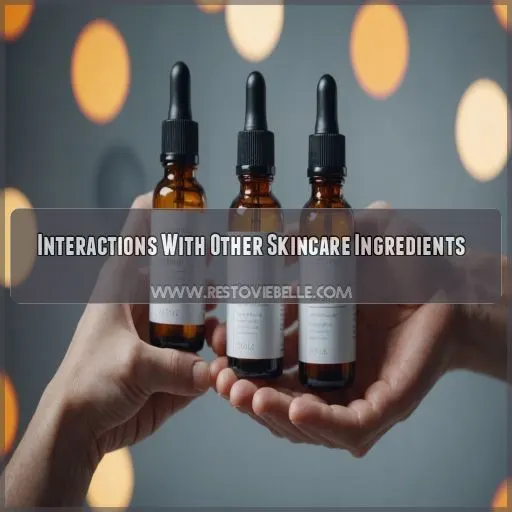This site is supported by our readers. We may earn a commission, at no cost to you, if you purchase through links.
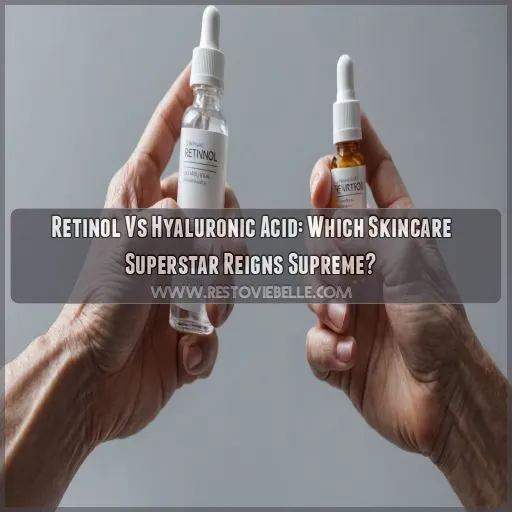
If you’re looking to add some serious moisture to your skin, hyaluronic acid is your go-to. It’s a humectant, which means it attracts and retains water, keeping your skin hydrated and plump. This natural substance is suitable for all skin types, especially dry and sensitive skin.
On the other hand, if you’re wanting to combat signs of aging, retinol might be your best bet. It stimulates collagen production, reduces wrinkles and fine lines, evens out skin tone, and treats acne. However, retinol can be irritating, especially for those with sensitive skin, and it increases sun sensitivity, so it’s best used at night.
The good news is, you don’t have to choose between them. These two ingredients work well together. Applying hyaluronic acid before retinol can help ease the side effects of retinol, like dryness and irritation. Just remember to always do a patch test before adding new products to your routine.
Table Of Contents
- Key Takeaways
- Hyaluronic Acid Vs Retinol: the Basics
- Skin Benefits of Hyaluronic Acid
- Skin Benefits of Retinol
- Similarities Between Hyaluronic Acid and Retinol
- Differences Between Retinol and Hyaluronic Acid
- Combining Hyaluronic Acid and Retinol
- Choosing the Right Product
- When to Use Hyaluronic Acid and Retinol
- Expected Results and Patience
- Interactions With Other Skincare Ingredients
- Frequently Asked Questions (FAQs)
- Is it better to use retinol or hyaluronic acid?
- Can I apply hyaluronic acid and retinol together?
- Is retinol or hyaluronic acid better for bags under eyes?
- What should you not use with retinol?
- Can I use retinol during the day?
- How long until I see results from hyaluronic acid?
- Is hyaluronic acid suitable for oily skin types?
- Can I mix retinol with other skincare products?
- Are hyaluronic acid and retinol safe for pregnancy?
- Conclusion
Key Takeaways
- Hyaluronic acid is your skin’s hydration hero, plumping it up and locking in moisture. It’s a gentle, effective hydrator for all skin types, especially dry and sensitive skin.
- Retinol is the anti-aging ace, stimulating collagen production, reducing wrinkles, and fighting acne. However, it can be irritating, so introduce it slowly and use it at night.
- You don’t have to choose between them. This dynamic duo works even better together, with hyaluronic acid easing any dryness or irritation caused by retinol.
- Both ingredients are widely available over the counter, but you can also get prescription-strength options for more potent results.
Hyaluronic Acid Vs Retinol: the Basics
You’re probably wondering which skincare superstar, hyaluronic acid or retinol, is right for you. Let’s break down the basics of these two popular ingredients to help you make an informed decision.
What is Hyaluronic Acid?
it’s a naturally occurring molecule that attracts and retains moisture, making it a hydrating superstar for your skin. Found in your body, it’s also used in skincare products to plump, smooth, and firm your skin. Think of it as a moisture magnet that leaves your skin feeling soft, supple, and refreshed.
What is Retinol?
So, you’re wondering what retinol is. In simple terms, retinol is a form of vitamin A that converts into retinoic acid in your skin. This powerhouse ingredient stimulates collagen production, reduces wrinkles and fine lines, and even helps with acne. It’s a game-changer for anti-aging, but be prepared for potential side effects like irritation and dryness.
Key Benefits of Hyaluronic Acid
hyaluronic acid is like a hydration superhero for your skin. It attracts and retains moisture, plumping up your skin and reducing the appearance of fine lines. With hyaluronic acid, you can expect a dewy glow, improved skin elasticity, and a stronger skin barrier. Plus, it’s gentle enough for sensitive skin types.
Key Benefits of Retinol
Now, let’s get into the key benefits of retinol. As a powerful skincare ingredient, retinol offers several advantages. Here are three key benefits to expect:
- Wrinkle reduction: Retinol stimulates collagen production, which helps reduce fine lines and wrinkles, leaving your skin looking smoother and more youthful.
- Acne treatment: Retinol unclogs pores, reducing acne and preventing future breakouts, while also fading acne scars and hyperpigmentation.
- Skin texture improvement: By increasing cell turnover, retinol helps remove dead skin cells, revealing brighter, more even-toned skin with a boost in skin texture.
Skin Benefits of Hyaluronic Acid
You’re probably already aware that hyaluronic acid is a hydrating powerhouse, but did you know it also has anti-inflammatory effects and can improve skin elasticity? As you learn more about this superstar ingredient, you’ll discover how it can plump and firm your skin, making it look smoother and more radiant.
Hydrating Properties
Hyaluronic acid is the ultimate skin quencher when it comes to hydrating properties. This natural humectant attracts and retains moisture, leaving your skin feeling soft, supple, and refreshed. As a dry skin solution, hyaluronic acid helps combat dehydration signs by locking in moisture, making it an essential addition to your hydration routine and moisturizing tips.
Anti-Inflammatory Effects
For soothing sensitive skin, hyaluronic acid is a game-changer. Its anti-inflammatory effects can reduce redness and irritation, making it perfect for those with inflammatory conditions. You’ll love how it:
- Calms and comforts the skin
- Reduces inflammation and redness
- Provides long-lasting hydration to sensitive skin
Skin Elasticity Improvement
If you’re looking to improve your skin’s elasticity, hyaluronic acid is your best friend.
By attracting and retaining moisture, it helps to plump up your skin, reducing the appearance of fine lines and wrinkles.
This means you can say goodbye to sagging skin and hello to a more youthful, radiant complexion.
With hyaluronic acid, your skin will look smoother, tighter, and more supple – and who doesn’t want that?
Plumping and Firming
Hyaluronic acid is a superstar for plumping and firming your skin. It attracts and retains moisture, making your skin look and feel firmer and more supple. This gives your skin a youthful, dewy appearance.
Skin Benefits of Retinol
Retinol, a form of vitamin A, is a powerhouse in skincare. It’s known for its ability to boost collagen production, smooth out wrinkles, and keep acne at bay. But that’s not all—retinol also helps even out skin tone and improve texture, giving your complexion a youthful glow-up.
Anti-Aging Properties
Retinol is a powerhouse for anti-aging. It increases cell turnover, boosting collagen production and reducing wrinkles. Retinol tightens pores and improves skin texture, giving you a youthful glow. But remember, it’s a long-term commitment, and you mightn’t see results overnight.
Collagen Production Stimulation
Retinol’s ability to stimulate collagen production is one of its superstar qualities. Here’s a quick breakdown:
- Collagen is like the scaffolding of your skin, keeping it firm and bouncy.
- As we age, collagen production slows down, leading to wrinkles and sagging skin.
- Retinol comes to the rescue by boosting collagen production, giving you a more youthful appearance.
- This collagen-stimulating effect is one of the key reasons retinol is so effective in reducing wrinkles and improving skin texture.
- It’s like giving your skin a natural facelift, but without the surgery!
Acne Treatment and Prevention
Retinol is a great tool in your acne-fighting arsenal. It’s like a superhero that swoops in to save the day by unclogging pores and preventing future breakouts. Here’s the lowdown on how retinol keeps your skin clear and blemish-free:
| Acne-Fighting Superpowers | How It Works | Your Skin’s Happy Ending |
| Unclogs Pores | Retinol increases cell turnover, clearing out the gunk that clogs pores and leads to acne. | Less clogged pores, fewer breakouts. |
| Prevents Future Breakouts | It also helps regulate oil production, so your skin stays balanced and acne has fewer opportunities to arise. | Less oily skin, fewer chances for acne to rear its ugly head. |
| Soothes Inflammation | The anti-inflammatory properties of retinol help calm angry, inflamed skin, reducing the redness and swelling associated with acne. | Less inflamed skin, less visible acne lesions. |
| Exfoliates Gently | Retinol provides a gentle exfoliating effect, sloughing off dead skin cells that can contribute to acne formation. | Less dead skin cell buildup, smoother skin, and reduced acne lesions. |
Now, this doesn’t mean retinol is a magic wand that will make acne disappear overnight. It’s more like a committed relationship—you’ve got to be patient and consistent to see results. Start with a lower potency and gradually work your way up to give your skin time to adjust.
Skin Tone Improvement
Retinol is your skin-brightening sidekick, helping to fade dark spots and even out skin tone. Here’s how:
- Banish Dark Circles: Retinol speeds up cell turnover, helping to lighten those stubborn under-eye circles.
- Fade Hyperpigmentation: Whether it’s sun damage, acne scars, or melasma, retinol’s cell-renewing powers help erase those spots.
- Get That Glow: By boosting collagen production, retinol gives your skin a youthful radiance, making dullness a thing of the past.
Similarities Between Hyaluronic Acid and Retinol
While hyaluronic acid and retinol have their unique benefits, there are some striking similarities between these two skincare superstars. In this section, we’ll explore the common ground they share and how they can both be powerful tools in your skincare arsenal.
Natural Occurrence
Retinol and hyaluronic acid are both natural superstars. They’re molecules found in the body and the environment. Hyaluronic acid is a sugar molecule that loves to hang out with water molecules, giving your skin a hydration hug. Retinol, a form of vitamin A, is like a superhero ready to transform into retinoic acid, fighting fine lines and wrinkles.
Skincare Benefits
both hyaluronic acid and retinol offer amazing skincare benefits. They can improve skin texture, reduce wrinkles, and address signs of aging. Plus, they’re both available over-the-counter and in prescription-strength formulas. So, what’s the difference? Well, hyaluronic acid is all about hydration, while retinol stimulates collagen production.
Acne Treatment
If you’re dealing with acne, retinol and hyaluronic acid can be your secret weapons.
Retinol helps unclog pores and prevent future breakouts.
Hyaluronic acid hydrates the skin, reducing inflammation.
For acne-prone skin, combining these ingredients can lead to a clearer, more balanced complexion.
Start with a gentle retinol product and pair it with a hydrating hyaluronic acid serum for a powerful skincare routine.
Availability and Prescription Strength
Now that we’ve covered acne treatment, let’s talk about availability and prescription strength. Both hyaluronic acid and retinol are widely available over-the-counter (OTC), but prescription-strength options are also available for more potent results. You can find OTC retinol products in various strengths, from 0.25% to 1.5%, while prescription retinol can range from 2% to 4%.
Differences Between Retinol and Hyaluronic Acid
Now that you know the basics of hyaluronic acid and retinol, it’s time to explore how they differ. From their mechanisms of action to their potential side effects, understanding these differences will help you make informed decisions about which skincare superstar to add to your routine.
Mechanism of Action
Now that we’ve covered the similarities between hyaluronic acid and retinol, let’s take a closer look at how they work differently. Here’s the breakdown:
- Retinol: Stimulates collagen production, increases cell turnover, and helps with skin texture and tone. It works deeper in the skin layers, making it a great option for anti-aging concerns.
- Hyaluronic Acid: Attracts and retains moisture, providing hydration and plumping the skin. It works on the skin’s surface, making it perfect for immediate hydration and skin elasticity improvement.
Key Takeaway: Understanding how each ingredient works will help you choose the right product for your skin concerns and needs.
Duration of Results
When it comes to how long you see results, hyaluronic acid and retinol work on different timelines. Hyaluronic acid provides immediate hydration, giving you a plumper, more radiant complexion within a week. Retinol, on the other hand, takes time to show results, requiring patience and consistent use for long-term anti-aging benefits.
Side Effects and Irritation
So, you’re wondering about the side effects and irritation of retinol and hyaluronic acid. Here’s the lowdown: retinol can cause redness, dryness, and sensitivity, especially if you have sensitive skin. Hyaluronic acid is generally gentler, but can still cause mild irritation. Remember to patch test, start with low concentrations, and always use sunscreen.
Depth of Action
When it comes to depth of action, retinol penetrates deeper into skin layers, stimulating collagen production and cell turnover. Hyaluronic acid, on the other hand, works on the surface, attracting and retaining moisture. Understanding how each ingredient interacts with your skin can help you create a skincare routine that addresses your unique concerns.
Combining Hyaluronic Acid and Retinol
When combining hyaluronic acid and retinol, you’ll want to apply the hyaluronic acid first to lock in moisture, followed by retinol to prevent irritation. By using these two skincare superheroes together, you can create a routine that tackles multiple skin concerns and gets you great results.
Synergistic Effect
When combining hyaluronic acid and retinol, you get a synergistic effect that enhances their individual benefits. Here’s what you can expect:
- Improved skin texture: Hyaluronic acid hydrates, while retinol stimulates collagen production, resulting in plumper, smoother skin.
- Enhanced anti-aging benefits: Retinol’s anti-aging properties are amplified by hyaluronic acid’s moisturizing effects, reducing fine lines and wrinkles.
- Better skin elasticity: Hyaluronic acid helps retain moisture, while retinol increases skin elasticity, giving you a more youthful appearance.
- Increased skin brightness: The combo helps reduce hyperpigmentation, resulting in brighter, more even-toned skin.
Recommended Usage and Order
Now that you know these two ingredients play well together, it’s time to talk about the order in which you should apply them. Here’s the golden rule: hyaluronic acid first, retinol last.
This order helps your skin get the full benefits of both ingredients. By applying hyaluronic acid first, you’re giving your skin a much-needed drink of water, plumping it up and preparing it for the retinol. Then, the retinol works its magic, stimulating collagen production and cell turnover while you sleep.
Consult a Dermatologist
If you’re unsure about combining hyaluronic acid and retinol, or have specific skin concerns, it’s a good idea to consult a dermatologist. They can provide personalized advice and a treatment plan suited to your skin. Skincare experts can guide you on the right products, usage, and any potential interactions.
Key Takeaway: Comprehensive Skincare Routine
The key takeaway here is that hyaluronic acid and retinol can be combined to create a well-rounded skincare routine for healthy, youthful skin.
Here’s how to do it:
- Lock in moisture first: Apply hyaluronic acid before retinol to maximize absorption and hydration.
- Supercharge your routine: Using both ingredients together can enhance their individual benefits, creating a synergistic effect.
- Consult a dermatologist: For personalized advice on combining these ingredients, patch testing, and creating a routine that works for your skin type, consult a skincare professional.
Choosing the Right Product
Choosing the right product is key to getting the most out of these skincare powerhouses.
But with so many options on the market, how do you decide which one is right for you?
In this section, we’ll give you the lowdown on hyaluronic acid molecular weight, retinol concentration, formulation considerations, and even some product recommendations to help you navigate the skincare aisle like a pro.
Hyaluronic Acid Molecular Weight
When choosing a hyaluronic acid (HA) product, it’s important to think about the molecular weight. HA comes in different sizes, and each size has unique benefits for your skin. Here’s the lowdown on HA molecular weight:
- Low-molecular-weight HA penetrates deeper into the skin, providing intense hydration to the lower layers.
- High-molecular-weight HA sits on top of the skin, creating a protective barrier that prevents moisture loss.
Retinol Concentration and Formulation
Retinol is a popular ingredient, but the concentration and how it’s made really matter. Here’s the lowdown:
- Start slow: Begin with a low dose of retinol and gradually increase the strength as your skin gets used to it.
- Pick the right stuff: Retinol comes in different forms, so you can find one that works for your skin type and what you’re looking for.
- Patch test: Always try a small amount on your skin first to see if it’s okay and to spot any irritation.
- Work your way up: Slowly add retinol to your routine, starting with using it less often and gradually increasing how often you use it.
Ingredient Compatibility
Mixing and matching skincare ingredients can feel like a puzzle. You want to find the right combo for glowing skin, but one wrong move could lead to irritation. So, how do retinol and hyaluronic acid work together?
This dynamic duo can work in harmony, but there’s a catch – you’ve got to layer them like a pro. Hyaluronic acid goes first, creating a hydrating base, then retinol steps in to seal the deal. This dream team can boost each other’s benefits, giving you a one-two punch of plumped-up, youthful skin. But remember, everyone’s skin is unique, so always test new products on a small patch of skin first.
Product Recommendations
When choosing a product, consider your skin type, concerns, and goals. Here are some top picks:
- Best budget options: The Ordinary’s retinol serums and hyaluronic acid serums
- Top-rated serums: Drunk Elephant’s retinol cream and Good Molecules’ hyaluronic acid serum, similar to peptide-rich moisturizers like Drunk Elephant peptide cream
- Drugstore picks: Neutrogena’s retinol moisturizer and Olay’s hyaluronic acid moisturizer
- High-end favorites: La Mer’s retinol serum and SkinCeuticals’ hyaluronic acid serum
- Affordable alternatives: Look for products with similar ingredients at a lower price point
When to Use Hyaluronic Acid and Retinol
So, you’ve heard the buzz about hyaluronic acid and retinol, but when should you use them? Is it morning, night, or both? And how often? Let’s figure out the best time for these skincare superstars to work their magic.
Hyaluronic Acid: Morning and Evening
When to use hyaluronic acid? Both morning and evening! Apply it on a clean face before moisturizers to lock in hydration. As it’s gentle and non-irritating, you can use it daily. For the best results, pair it with retinol in the evening, but remember to start with a low dose of retinol and gradually increase.
Retinol: Evening Use
If you’re thinking about using retinol, nighttime is the way to go. This is because retinol can make your skin more sensitive to the sun, and using it at night helps minimize this risk. Plus, retinol works best when your skin is in a state of repair, which happens naturally at night.
- Apply retinol after cleansing and toning your skin.
- Start with a lower concentration and gradually increase as your skin becomes more tolerant.
- Be patient, as retinol can take time to show results.
- Don’t forget to moisturize after applying retinol to help soothe and hydrate your skin.
- Consider using a retinol product that’s specifically formulated for nighttime use.
Start With a Low Dose of Retinol
When introducing retinol into your skincare routine, start with a low dose to avoid irritation.
This is especially important if you’re new to retinol or have sensitive skin.
Begin with a product containing around 0.25% retinol and patch test it on a small area for a few days.
If you don’t experience any adverse reactions, you can gradually increase the frequency or concentration of retinol.
Gradually Increase Retinol Strength
So, you’ve started with a low dose of retinol and now it’s time to gradually increase the strength. Remember, patience is key! As your skin becomes more tolerant, you can bump up the concentration. Always patch test and start with a small area to make sure you don’t experience any adverse reactions.
Expected Results and Patience
So, you’re wondering when you’ll start seeing results from using hyaluronic acid and retinol. The truth is, these ingredients work on different timelines, and you need to understand their unique benefits and patience requirements to get the most out of your skincare routine.
Hyaluronic Acid: Immediate Hydration
You’re probably excited to see results from using hyaluronic acid. The good news is that you can expect:
- Immediate hydration and plumping of the skin
- Reduced appearance of fine lines and wrinkles within a week
- A stronger skin barrier after four weeks
- Improved skin elasticity and firmness
- Reduced puffiness and dark circles under the eyes
Retinol: Long-Term Anti-Aging Benefits
When using retinol, you gotta be realistic about what to expect.
Retinol works slowly, and you might not see instant results.
It takes time to stimulate collagen production, reduce fine lines, and improve skin texture.
Be patient, and don’t get discouraged if you don’t see changes right away.
Stick to your skincare routine, and you’ll start noticing long-term anti-aging benefits over time.
Be Patient With Retinol Results
retinol takes time to show results. It’s not a magic wand that’ll erase wrinkles overnight. Be patient, and don’t give up! It can take a few weeks to a few months to see the benefits. Stick to your skincare routine, and remember, consistent use is key. Results may vary, but with retinol, patience is key to achieving long-term anti-aging benefits.
Consistency is Key
Now that you’ve started using retinol, it’s important to be consistent with your daily routine. Remember, patience is key for seeing long-term results. Building tolerance to retinol takes time, so stick to your skincare routine and don’t get discouraged if you don’t see immediate results. With consistent use, you’ll start to notice a transformation in your skin.
Interactions With Other Skincare Ingredients
When combining retinol and hyaluronic acid with other skincare ingredients, you need to think about how they interact to get the most benefits and avoid any problems. You’ll want to know how these powerhouses work with other popular ingredients, like glycolic acid, vitamin C, and exfoliants, to create a skincare routine that works well.
Retinol and Glycolic Acid
When combining retinol with glycolic acid, be cautious of increased skin sensitivity and potential irritation. Start with a lower concentration of glycolic acid (around 5-7%) and retinol (around 0.25%) to minimize adverse reactions.
- Always patch test before using these ingredients together.
- Use sunscreen daily to prevent sun sensitivity.
- Gradually increase product strength as your skin becomes more tolerant.
Retinol and Vitamin C
Retinol and vitamin C are like a dynamic duo, but with unique superpowers. Vitamin C is a morning must-have, as it’s a powerful antioxidant that shields your skin from the day’s stressors, like pollution and UV rays. It’s also a brightening agent, fading dark spots and giving you a radiant glow.
But, remember, these two can be a bit of a tricky pair. Vitamin C has an acidic nature, which can irritate sensitive skin, especially when combined with retinol’s potent effects. So, to avoid any skincare drama, use retinol at night and vitamin C in the morning. This way, you’ll get the best of both worlds without overloading your skin.
Hyaluronic Acid and Other Exfoliants
Hyaluronic acid plays well with exfoliants like salicylic acid, glycolic acid, and other AHAs and BHAs. This means you can safely incorporate hyaluronic acid into your exfoliation routines without worrying about negative interactions.
Key Takeaway: Ingredient Compatibility
When mixing retinol and hyaluronic acid with other skincare ingredients, it’s important to think about their compatibility to avoid negative interactions.
For example, retinol and glycolic acid shouldn’t be used together due to increased sun sensitivity and irritation.
However, retinol and vitamin C can be used together, but it’s best to use retinol at night and vitamin C in the morning.
Hyaluronic acid, a friendly ingredient, pairs well with exfoliants like salicylic acid and glycolic acid.
Frequently Asked Questions (FAQs)
Is it better to use retinol or hyaluronic acid?
So, you’re wondering which skincare superhero to call upon: retinol or hyaluronic acid? It depends on your skin concerns! Retinol is ideal for anti-aging and acne, while hyaluronic acid provides intense hydration and plumps up your skin.
Can I apply hyaluronic acid and retinol together?
You can definitely use hyaluronic acid and retinol together, but apply them in the right order: start with hyaluronic acid to lock in moisture, then follow up with retinol to minimize irritation and maximize benefits.
Is retinol or hyaluronic acid better for bags under eyes?
For bags under eyes, hyaluronic acid is your best bet – it plumps up the skin, reducing fine lines and wrinkles, and provides immediate hydration. Retinol, on the other hand, is better suited for long-term anti-aging benefits, like stimulating collagen production and cell turnover.
What should you not use with retinol?
When using retinol, avoid mixing it with glycolic acid, as it can increase sun sensitivity and irritation. Instead, pair retinol with hyaluronic acid or vitamin C to maximize its benefits and minimize potential side effects.
Can I use retinol during the day?
You shouldn’t use retinol during the day, as it can make your skin more susceptible to UV rays and increase the risk of irritation. Instead, apply it at night and follow up with a broad-spectrum sunscreen in the morning.
How long until I see results from hyaluronic acid?
You’ll start seeing results from hyaluronic acid within a week, with improved skin hydration and a stronger skin barrier. Be patient, and you’ll notice even more benefits after four weeks of consistent use.
Is hyaluronic acid suitable for oily skin types?
You’re wondering if hyaluronic acid is suitable for oily skin types? Good news: it’s a great option! Hyaluronic acid helps regulate moisture levels, won’t clog pores, and can even reduce oil production, making it a perfect addition to your skincare routine.
Can I mix retinol with other skincare products?
When combining retinol with other products, start with a low concentration and patch test to avoid irritation. For example, mix a few drops of retinol serum with your moisturizer to create a customized blend that suits your skin type and needs.
Are hyaluronic acid and retinol safe for pregnancy?
When pregnant, consult your doctor before using hyaluronic acid or retinol, as both can be safe in moderation, but high concentrations of retinol may pose risks; always prioritize your healthcare provider’s advice over online guidance.
Conclusion
Time to get real – your skin isn’t getting any younger!
So, which skincare superstar should you enlist in the battle against dryness and aging?
The verdict is in: both retinol and hyaluronic acid are essential for a good skincare routine.
By understanding their unique strengths and weaknesses, you can harness their powers to achieve hydrated, plump, and youthful-looking skin.
Mix and match these skincare superheroes to get the best skin you can!

